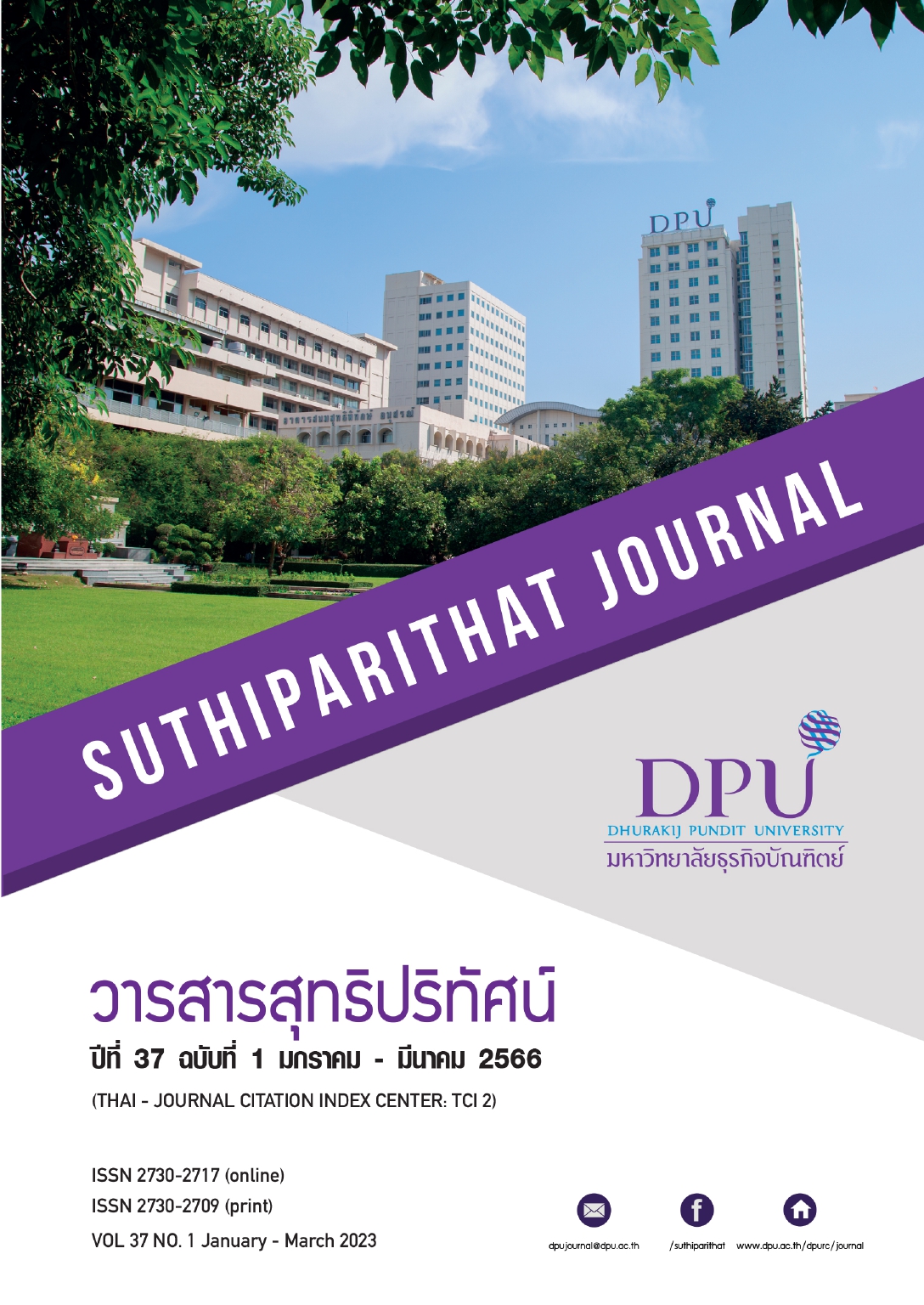ความสัมพันธ์เชิงอิทธิพลของปัจจัยในที่ทำงานต่อขวัญและกำลังใจในการปฏิบัติงานของพนักงาน
คำสำคัญ:
ความสัมพันธ์เชิงอิทธิพล, ระดับความพึงพอใจ, พนักงาน, ปัจจัยในที่ทำงาน, ขวัญและกำลังใจในการปฏิบัติงานบทคัดย่อ
การวิจัยครั้งนี้มีวัตถุประสงค์เพื่อ ศึกษาลักษณะทั่วไปของตัวอย่าง ศึกษาระดับความพึงพอใจปัจจัยในที่ทำงานของพนักงานเอกชน รวมถึงศึกษาความสัมพันธ์เชิงอิทธิพลของปัจจัยในที่ทำงานต่อขวัญและกำลังใจในการปฏิบัติงานของพนักงานประชากรที่ใช้ในการศึกษาคือ พนักงานที่ปฏิบัติงานอยู่ในบริษัทเอกชนแห่งหนึ่ง ใช้แบบสอบถามเชิงโครงสร้างในเก็บรวบรวมข้อมูล วิเคราะห์ข้อมูลด้วยค่าสถิติเชิงพรรณนา และสถิติเชิงอนุมาน (การวิเคราะห์ถดถอยเชิงเส้นแบบพหุคูณ) ผลการศึกษา พบว่า ปัจจัยในที่ทำงานมีความสัมพันธ์เชิงอิทธิพลต่อขวัญและกำลังใจในการปฏิบัติงานของพนักงาน อย่างมีนัยสำคัญที่ระดับ 0.05 ค่าสัมประสิทธิ์พหุคูณ (R = 0.375) และ (F =24.181) โดยมีตัวแปรที่สำคัญคือ ความเป็นธรรมขององค์การ (.350) ความพอเพียงของรายได้ (.276) ความมั่นคงปลอดภัยในการทำงาน (.259) สภาพการทำงาน (.251) ความสัมพันธ์ระหว่างหัวหน้างานและลูกน้อง (.249) และสวัสดิการขององค์การ (.221) ตามลำดับ
เอกสารอ้างอิง
เกียรติคุณ พลเยี่ยม. (2556). ขวัญและกำลังใจในการปฏิบัติงานของพนักงานส่วนตำบล สังกัดองค์การบริหารส่วนตำบลในเขตจังหวัดร้อยเอ็ด [วิทยานิพนธ์ปริญญามหาบัณฑิต, มหาวิทยาลัยราชภัฏอุดรธานี]. ศูนย์วิทยบริการมหาวิทยาลัยราชภัฏอุดรธานี. http://www.phothong101.go.th/data/Knowledge/Research/A%20STUDY%20OF%20THE%20MORALE%20.pdf
ธัญพร สินพัฒนพงค์ (2560). ปัจจัยที่ส่งผลต่อความพึงพอใจในการทำงานของพนักงานการไฟฟ้านครหลวง จังหวัดกรุงเทพมหานคร [การค้นคว้าอิสระปริญญามหาบัณฑิต, มหาวิทยาลัยธรรมศาสตร์]. ห้องสมุดแห่งมหาวิทยาลัยธรรมศาสตร์. http://ethesisarchive.library.tu.ac.th/thesis/2017/TU_2017_5902030070_7983_6531.pdf
สิรินาตย์ กฤษฎาธาร. (2552). ความผูกพันต่อองค์กรของพนักงานบริษัท การบินไทย จำกัด (มหาชน) [วิทยานิพนธ์ปริญญามหาบัณฑิต, มหาวิทยาลัยราชภัฏวไลยอลงกรณ์ ในพระบรมราชูปถัมภ์]. มหาวิทยาลัยราชภัฏวไลยอลงกรณ์ ในพระบรมราชูปถัมภ์.
Akabas, K. S., & Kurzman, P. A. (2007). Work and The workplace: A resource for innovative policy and practice. Columbia University Press. https://doi.org/10.7312/akab11166
Boelkes, D. (2020). The wow factor workplace. Business World Rising.
Cohen, A. (2015). Fairness in the workplace: A global perspectives. Palgrave Macmillan.
Couser, G. P. (2008). Challenges and opportunities for preventing depression in the workplace: A review of the evidence supporting workplace factors and interventions. Journal of Occupational and Environmental Medicine, 50(4), 411–427. https://doi.org/10.1097/JOM.0b013e318168efe2
Davis, K. (1972). Human relations at work. McGraw-Hill.
Herzberg, F., Mausner, B., & Snyderman, B. B. (1959). The motivation of work. John Wiley & Sons.
Krejcie, R. V., & Morgan, D. W. (1970). Determining sample size for research activities. Journal of Education and Psychological Measurement, 30(3), 607-610. https://doi.org/10.1177/001316447003000308
Mathis, R. J., & Jackson, J. S. (2002). Human resource management (10th ed.). Thomson Learning South Western.
Miller, K. (2012). Organizational communication: Approaches and processes (6th ed.). Wadsworth Cengage Learning.
Mowday, R. T., Porter, L. W., & Steer, R. M. (1982). Employee organization linkage: The psychology of commitment. Academic.
Muchinsky, P. M. (1993). Psychology applied to work: An introduction to industrial and organization psychology. Cole.
ดาวน์โหลด
เผยแพร่แล้ว
รูปแบบการอ้างอิง
ฉบับ
ประเภทบทความ
สัญญาอนุญาต
ลิขสิทธิ์ (c) 2023 มหาวิทยาลัยธุรกิจบัณฑิตย์

อนุญาตภายใต้เงื่อนไข Creative Commons Attribution-NonCommercial-NoDerivatives 4.0 International License.
เนื้อหาและข้อมูลในบทความที่ลงตีพิมพ์ในวารสารสุทธิปริทัศน์ ถือเป็นข้อคิดเห็นและความรับผิดชอบของผู้เขียนบทความโดยตรงซึ่งกองบรรณาธิการวารสาร ไม่จำเป็นต้องเห็นด้วย หรือร่วมรับผิดชอบใด ๆ
บทความ ข้อมูล เนื้อหา รูปภาพ ฯลฯ ที่ได้รับการตีพิมพ์ในวารสารสุทธิปริทัศน์ ถือเป็นลิขสิทธิ์ของวารสารสุทธิปริทัศน์หากบุคคลหรือหน่วยงานใดต้องการนำทั้งหมดหรือส่วนหนึ่งส่วนใดไปเผยแพร่ต่อหรือเพื่อกระทำการใด ๆ จะต้องได้รับอนุญาตเป็นลายลักษณ์อักษรจากวารสารสุทธิปริทัศน์ก่อนเท่านั้น







